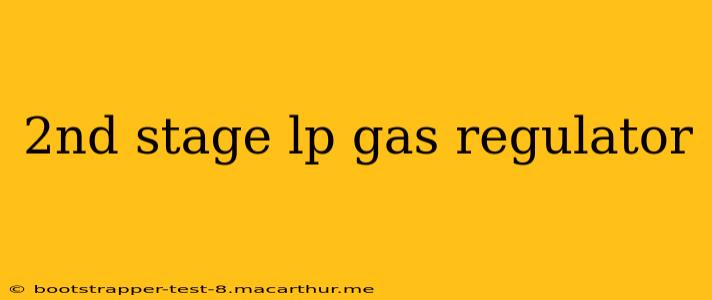LPG, or liquefied petroleum gas, is a widely used fuel for cooking and heating. A crucial component in ensuring safe and efficient LPG usage is the regulator. This guide focuses specifically on the second-stage regulator, explaining its function, components, troubleshooting, and safety considerations. We'll also answer some frequently asked questions to provide a complete understanding of this vital piece of equipment.
What is a 2nd Stage LPG Regulator?
The LPG system typically uses a two-stage pressure reduction process. The first stage regulator, often located at the gas cylinder, reduces the high pressure within the cylinder to a medium pressure. The second-stage regulator, then, takes this medium pressure and further reduces it to a low, safe pressure suitable for use in appliances like stoves and heaters. This final pressure reduction ensures consistent gas flow to your appliances without excessive pressure fluctuations. Think of it as a carefully controlled valve, ensuring your gas flows smoothly and safely to the point of use.
How Does a 2nd Stage LPG Regulator Work?
The second-stage regulator operates using a diaphragm and spring mechanism. The incoming medium-pressure gas pushes against the diaphragm. The spring opposes this force, creating a balance that regulates the output pressure. When the gas appliance is turned on, the pressure drops slightly downstream, allowing the diaphragm to move, opening the valve and allowing more gas to flow. This self-regulating mechanism maintains a constant low pressure regardless of fluctuations in demand.
What are the Components of a 2nd Stage LPG Regulator?
While designs can vary slightly among manufacturers, most second-stage LPG regulators share these key components:
- Inlet: This is where the medium-pressure gas enters from the first-stage regulator.
- Diaphragm: A flexible membrane that separates the high-pressure gas from the low-pressure side. Its movement controls the gas flow.
- Spring: Provides the counter-force to the diaphragm, determining the output pressure.
- Valve: Controls the flow of gas based on the diaphragm’s movement.
- Outlet: This is where the low-pressure gas exits to the appliance.
Why is a 2nd Stage LPG Regulator Important?
The second-stage regulator is critical for several reasons:
- Safety: It reduces the pressure to a safe level, preventing dangerous pressure buildup in gas lines and appliances.
- Efficient Operation: Provides a consistent gas flow to appliances, ensuring optimal performance.
- Prevents Leaks: A properly functioning regulator minimizes the risk of gas leaks.
- Prolonged Appliance Life: Consistent, safe gas flow contributes to the longevity of your gas appliances.
What are the Signs of a Faulty 2nd Stage LPG Regulator?
Several indicators might suggest your second-stage regulator needs attention:
- Weak or inconsistent gas flow: This is a common symptom, indicating the regulator may not be regulating pressure effectively.
- Gas leaks: Always check for any gas leaks around the regulator—the smell of gas is a clear indication.
- No gas flow at all: This could indicate a complete failure of the regulator.
- Hissing sound: A continuous hissing sound from the regulator indicates a leak.
How to Troubleshoot a 2nd Stage LPG Regulator?
Important Note: If you suspect a gas leak, immediately turn off the gas supply and contact a qualified gas technician. Do not attempt repairs yourself unless you have proper training and expertise. A gas leak is extremely dangerous.
If you are experiencing weak gas flow or other minor issues that don't involve gas leaks, you can try:
- Checking for blockages: Ensure there are no obstructions in the gas line between the regulator and the appliance.
- Inspecting the regulator for damage: Look for any signs of physical damage, cracks, or corrosion.
How Often Should I Replace My 2nd Stage LPG Regulator?
While there's no strict timetable, it's advisable to have your second-stage regulator inspected and potentially replaced every few years or as recommended by the manufacturer. Regular inspection helps identify potential problems before they become safety hazards.
Can I Repair a 2nd Stage LPG Regulator Myself?
No, attempting to repair a second-stage regulator yourself is strongly discouraged. These devices require specialized knowledge and tools to repair safely and effectively. Improper repair can lead to dangerous gas leaks and malfunctions. Always contact a qualified gas technician for any repair or replacement needs.
What are the Safety Precautions When Using an LPG Regulator?
- Always check for leaks: Before using any LPG appliance, check for gas leaks using soapy water.
- Never use a damaged regulator: Replace a damaged regulator immediately.
- Follow manufacturer's instructions: Always adhere to the manufacturer's instructions for installation and use.
- Regular inspection: Regularly inspect the regulator for any signs of damage or malfunction.
By understanding the function and importance of the second-stage LPG regulator, you can ensure the safe and efficient operation of your gas appliances. Remember, safety is paramount; always contact a qualified technician for any repairs or concerns.
